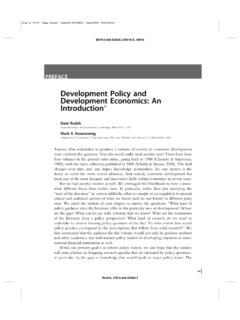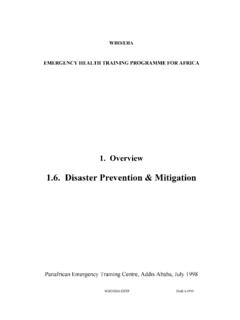Transcription of Decentralization: Pros and Cons - Florida Sheriffs Association
1 decentralization : Pros and Cons Tommy Aman Abstract The St. Johns County Sheriff's Office is researching the possibility of implementing decentralization . This paper studies the benefits and the obstacles for the organization. A survey was sent out to nine Sheriffs ' offices and one police department within the State of Florida that are, currently decentralized. The surveys and the research showed important data to reflect what agencies experienced who have decentralized. Areas of concern were identified along with some benefits of decentralization of an organization. Possible solutions to some of the problems associated with decentralization are also discussed. Introduction The population of St. Johns County has increased dramatically over the past fifteen years. In 1990, the County had a population of only 83,972 which increased to a population of 155,154 by 2005 (Conner, 2008). This unprecedented population growth in the County has increased the calls for service for the St Johns County Sheriff's Office.
2 As a result, the agency has been forced to increase the number of deputies to meet the demand. Because the Agency and County population have grown so dramatically over the past twenty years, it has become imperative that the Agency look at various ways of restructuring and reorganizing. Currently, the St. Johns County Sheriff's Office operates from a centralized structure and command. All of the decisions and authority come from an Executive Command with the Sheriff as its CEO. The purpose of this paper is to look at decentralization of the Agency and whether such reorganization is a viable option, especially in today's economic climate. Specifically, I want to examine the advantages and disadvantages of decentralization and whether the Sheriff's Office should remain centralized. It is my intent to examine the issue of reorganization and to provide our staff with data to help with the decision to either stay with a centralized structure or make a change to a decentralized structure.
3 Literature Review Definition In order to properly acknowledge the problem it would be important to give a proper definition of decentralization and centralization. In his book review of Organizational Structure in American Police Agencies, Thomas Shevory quotes the author, Edward R. Maguire on the definition of centralization. Maguire defines centralization as, the degree to which the decision-making capacity within the 1. organization is concentrated in a single Individual or small group (Shevory, 2003). decentralization is defined as, if a mid-manager in a centralized agency is placed in charge of a new non-centralized operating site, and given considerable responsibility over local operations, decision-making responsibility has been shifted downward (vertical) and outward (horizontal) (Shevory, 2003). History of American Policing Most of the police organizations in the United States were influenced by how the colonies were formed from the settlers from the British Empire.
4 The Sheriff was the most important law enforcement official in colonial America (CliffNotes, ). Early policing and police organizations were structured by the model by Sir Robert Peele in London and it was a military command structure. Police organizations in the United States became more quasi-military but each jurisdiction had its on police organization. (Chappell & Kaduce, 2004). The American people have always been suspicious of a centralized police force or a national police force. This fear of a national police force has led to a decentralized police force in the United States which has brought about multiple police agencies which brings about waste and a duplication of services in many areas (CliffNotes, ). International Police Organizations In most European countries police organizations are centralized with a national police force. This is also true with many Asian countries which chose to have national police organizations.
5 The Republic of China Taiwan is an example of a country which has a centralized police force and very effective. The country has a low crime rate and a top rated training program for officers that have been recognized by most police administrators (Kurtz, 1995). According to Howard Kurtz, the nations of the world have a very important decision to make and that is whether countries police forces should be centralized or decentralized. Centralization is looked at as a huge danger to democracy as well as personal freedom. decentralization is viewed as very inefficient and fragmented. (Kurtz, 1995). The international community does not have small departments spread out over numerous jurisdictions as the United States has. With a national police force these countries are able to better train their personnel and have a standardized service oriented police force. (Kurtz, 1995). National Level When discussing police organizations and how they are structured here in the it might help to look at some history on the national level.
6 Police organizations went through three specific periods of change and transition from the early 19th century. These periods of change are divided into the Political Era, Reform Era and the Community Problem-Solving Era. (Kelling & Moore, 1988). 2. During the Political Era, from the late 1800s to early 1900s, the police had very close ties to the politicians who were the authority the police worked under. The police and the politicians had such tight links that the police were often seen as extensions of the politicians who were in office at the time. The police were used for crime prevention but also served as social services when necessary. Most police organizations were quasi-military organizations with a centralized command yet divided into districts or precincts. This was the era of foot patrols where officers became very familiar with citizens and business owners. (Kelling &. Moore, 1988). The Reform Era which lasted from the 1930's into the 1970's was brought about because of ongoing corruption within police departments.
7 This was an extension of the ties with the politicians and the citizens within the communities the police were serving. The reformers wanted an end to the close relationships with the politicians and the police departments. In some cities officers were not allowed to patrol the area they lived in to avoid any sign of political influence. The very goal of the police during this time period was to control crime and enforce the law. The organizational structure of police agencies was centralized and the control and authority came from the top of the department. (Kelling & Moore, 1988). Police communication equipment and 911 systems allowed the police to respond faster to calls for service. Officers were placed in high visibility vehicles to patrol large areas and gave a sense that the police were everywhere to deter criminal activity. The connection between the police and the citizen within the neighborhood and business became a thing of the past.
8 Foot patrol was looked down upon as an outdated mode of policing and rejected as expensive and inefficient. (Kelling & Moore, 1988). The reform model was used to reduce corruption within the departments and politicians. Yet information that police used to solve crimes began to dry up as the police lost contact with the community and its eyes and ears to criminal activity. (Chappell & Kaduce, 2004). The third era is the Community Problem Solving or COPS and it began in the late 1970's and early 1980's. (Kelling & Moore, 1988). What the police found out was that they were lacking in the citizen-police interaction and they needed information. It was very hard to solve crime without information and the police were patrolling from a vehicle not walking a beat. The foot patrol made a comeback and is working well in several communities across the United States. One such place is Flint Michigan where the police decided to have officers walking a beat across the entire city.
9 Politicians and upper brass of police departments have found citizens helping to solve problems and crime within their communities. Police started working with other agencies to bring about resolution and the front line officers had more tools to attack a problem. (Kelling &. Moore,1998). The problem with implementation of COPS has been the structure of the organization to make it work properly. Most police agencies need to decentralize in order to make COPS effective but are having a difficult time determining how to restructure. (Chappell & Kaduce, 2004). 3. A National Example The City of New Orleans in the late 1980's and most of the 1990's had one of the highest homicide rates in the country. The city's crime rate was rising and the police department was under investigation for corruption by the federal government. Police morale was very low. (Pitts, 1997). The city hired a new police chief to help turn the situation around.
10 Police Chief Richard Pennington (Pennington is currently the Police Chief of Atlanta Ga.) found the police force needed to be restructured. He brought people from outside the department to help with the restructuring. (Pitts, 1997). The New Orleans Police Department experienced one of the largest restructuring in its history. Chief Pennington began decentralizing the department and divided the agency with eight district commanders. Each of the district commanders was responsible for his district and accountability of the actions taken. Officer's salaries had to be increased and ethics training was mandatory. The agency began to train its officers in community-policing techniques as well as updating technology and equipment. A system of COMSTAT was brought to the agency to help tract data with dealing with crime and the solutions to the problem areas. (Pitts, 1997). Florida Level The community-oriented policing programs are the fastest growing initiatives in law enforcement agencies today.











